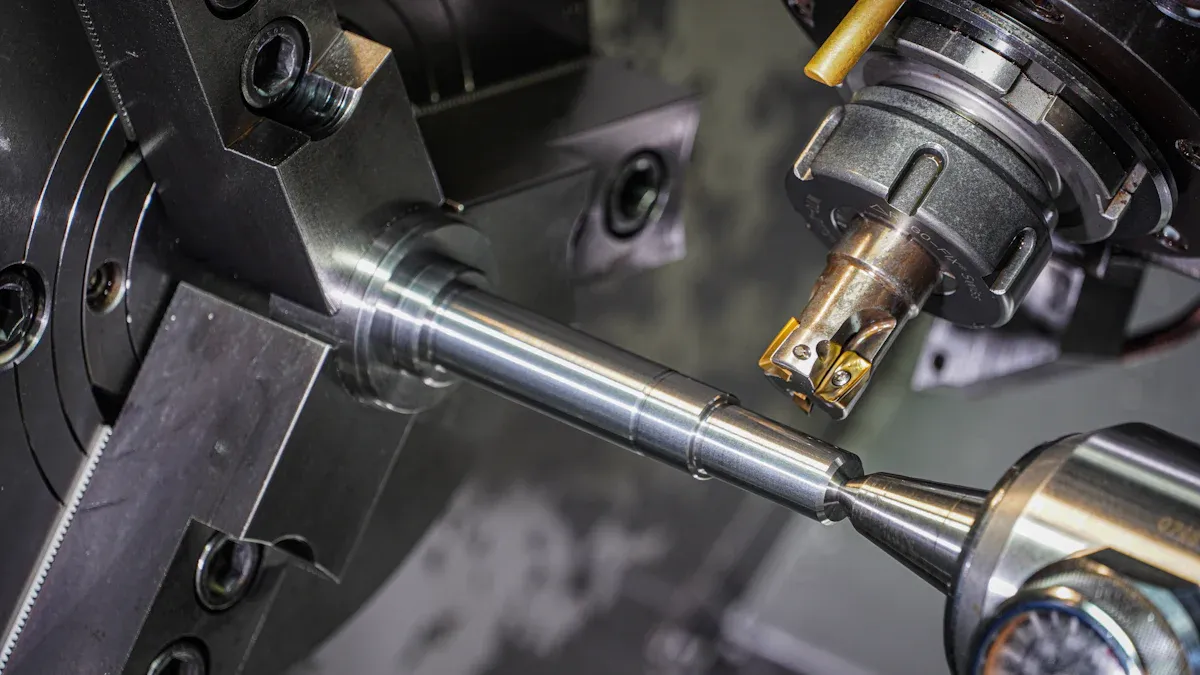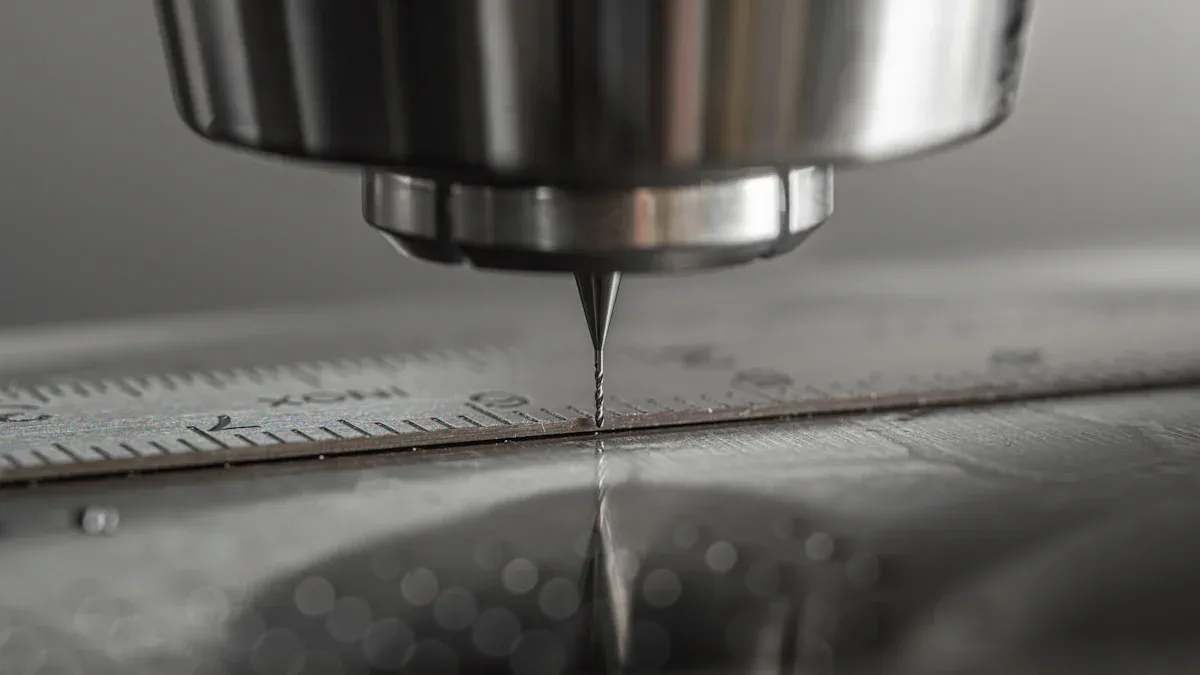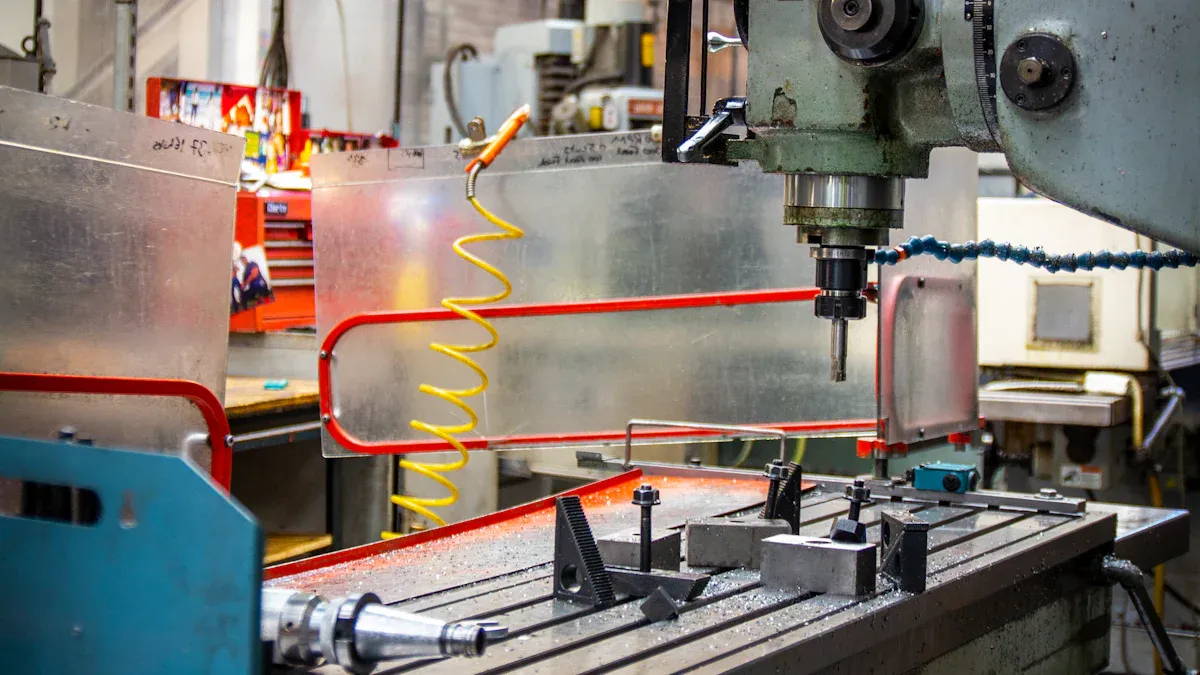Can You CNC Stainless Steel?
Stainless steel is a fascinating material. Its strength and corrosion resistance make it ideal for precision manufacturing. With CNC machining, we can machine stainless steel into intricate designs with extreme precision. Thanks to advances in technology, this process has become more efficient. Today, CNC machining shops use innovative tools and techniques to easily process stainless steel. These improvements allow you to produce high-quality parts while keeping production costs under control.

Image Source: unsplash
Key Takeaways
- CNC machining is very accurate, with tolerances as small as ±0.001 inches. This makes it great for industries needing exact measurements.
- Picking the right stainless steel, like SS303 for easy cutting or SS316 to resist rust, is important for good results.
- Special cutting tools and coatings help tools last longer and work better when cutting stainless steel.
- Using smart cooling methods, like tiny amounts of lubricant with nanoparticles, improves surface finish and keeps heat problems low.
- CNC machining saves money on complex designs by cutting labor costs and speeding up production, especially for large orders.
Why CNC Machining Works for Stainless Steel

Properties of Stainless Steel That Make It Suitable for CNC Machining
Stainless steel combines strength, corrosion resistance, and machinability. These properties make it an excellent material for CNC machining.
- Strength: Stainless steel, especially the 304 grade, boasts a tensile strength of around 505 MPa. This makes it stronger than most aluminum alloys, allowing it to withstand high-stress applications.
- Corrosion Resistance: The 316L grade contains 2-3% molybdenum, which provides exceptional resistance to corrosive environments like saltwater. This makes it ideal for marine and chemical applications.
- Machinability: Some grades, like SS303, include 0.15% sulfur. This addition improves machinability by preventing heat hardening during cutting, which is crucial for maintaining precision.
| Property | Description |
|---|---|
| Strength | Tensile strength around 505 MPa for 304 grade, stronger than most aluminum alloys. |
| Corrosion Resistance | 316L contains 2-3% molybdenum, providing exceptional resistance to corrosive environments, including saltwater. |
| Machinability | SS303 contains 0.15% sulfur, improving machinability and preventing heat hardening during cutting. |
These physical properties ensure that stainless steel performs well under the demanding conditions of CNC machining.
Common Applications of CNC Machined Stainless Steel
CNC machining has opened up a world of possibilities for stainless steel. It used in a variety of industries, each with its own unique requirements. Here are some examples:
- Precision-Machined Valve Components: These parts often require tight tolerances and durability. CNC machining achieves a scrap rate of less than 2% across 500 units, with zero leaks reported after six months in service.
- Custom Marine Hardware: For marine environments, corrosion resistance is critical. Proper polishing and post-machining passivation ensure these parts maintain their integrity.
- Food-Grade Equipment Parts: Sanitary standards are non-negotiable in the food industry. CNC machining uses low-burr toolpath strategies to meet health regulations.
In addition, CNC machining has improved productivity in stainless steel manufacturing. For instance, a fan manufacturing company implemented the DMAIC methodology, leading to significant gains in both quality and output. Another company identified bottlenecks and adjusted processes, resulting in higher productivity rates.
Choosing Stainless Steel Grade for CNC Machining
Choosing the right stainless steel grade is essential to achieving the best results. Before making your choice, you can consider the specific requirements of your project. Here is a quick guide:
- 18/0 Stainless Steel: This ferritic grade (also known as grade 430) contains 18% chromium and no nickel. It’s cost-effective and doesn’t work-harden, making it easier to machine. However, it offers lower corrosion resistance compared to other grades.
- 304 Stainless Steel: This is the most common austenitic grade. It provides good corrosion resistance and is suitable for a wide range of applications.
- 316 Stainless Steel: Known for its superior corrosion resistance, especially in marine environments, this grade is perfect for applications exposed to harsh conditions.
| Stainless Steel Grade | Tool Wear Behavior | Surface Finish Achievable |
|---|---|---|
| 18/0 | More predictable wear patterns during machining | Ra < 0.8 µm without secondary polishing |
| 304 | Sudden tool chipping when work-hardened | N/A |
| 316 | N/A | N/A |
The choice of grade also affects the machining process. For example, 18/0 stainless steel does not work harden as easily as austenitic stainless steel, which simplifies CNC machining. On the other hand, 304 and 316 grades require more careful processing to avoid tool wear and maintain surface quality.
Challenges of CNC Machining Stainless Steel
Hardness and Toughness of Stainless Steel
Stainless steel’s hardness and toughness present significant challenges during CNC machining. Its high cutting resistance requires durable tools and precise techniques to achieve accurate results. For example, stainless steel 304 has a hardness of 210 HBW and low thermal conductivity (16 W/m·K), which increases tool wear and machining difficulty compared to materials like aluminum 6061.
| Material | Hardness (HBW) | Thermal Conductivity (W/m·K) | MRR (mm³/min) | Challenges in Machining |
|---|---|---|---|---|
| Stainless Steel 304 | 210 | 16 | 0.6 | High cutting resistance, increased tool wear |
| Aluminum 6061 | N/A | N/A | High | Low cutting resistance, efficient heat transfer |
Stainless steel also impacts tool performance. Tools often experience rapid wear, which affects precision and increases maintenance costs. Regular upkeep is essential to mitigate these effects and extend tool life.
Tip: Using advanced cutting tools with wear-resistant coatings can help reduce tool wear and improve machining efficiency.
Heat Generation and Tool Wear
Heat management is another critical challenge when machining stainless steel. Its low thermal conductivity causes most of the heat generated during machining to remain concentrated in the material. This heat buildup accelerates tool wear, creates dimensional accuracy problems, and leads to poor surface finishes.
- Stainless steel retains heat, causing rapid heating during machining.
- Built-up edge formation and thermal expansion affect the final product’s quality.
- Effective cooling and lubrication strategies are essential to manage heat and maintain precision.
- High heat generation can cause thermal expansion, impacting dimensional stability.
- Cooling systems and lubricants help dissipate heat and protect tools from excessive wear.
CNC machining factories often use specialized coolant systems to address these challenges. These systems improve heat dissipation and ensure consistent machining results.
CNC Stainless Steel Machined Parts Surface Treatment
Post-machining surface treatment plays a vital role in enhancing the quality and durability of stainless steel parts. Cleaning removes impurities, while polishing improves surface smoothness and corrosion resistance. Electrolytic polishing, in particular, offers efficiency and anti-corrosion benefits.
- Cleaning: Removes impurities to prepare the surface for treatment.
- Polishing: Mechanical, electrolytic, and chemical methods enhance surface finish.
- Pickling and Passivation: Improves corrosion resistance for various stainless steel grades.
- Protection: Prevents contamination after treatment.
CNC machining factories adopt these techniques to deliver high-quality stainless steel components. Proper surface treatment ensures the parts meet industry standards and perform well in demanding environments.
Innovations and Techniques for Precision CNC Machining of Stainless Steel

Advanced Cutting Tools and Coatings
How advanced cutting tools and coatings have revolutionized stainless steel CNC machining. These innovations extend tool life, improve machining accuracy, and reduce wear during machining. Here are some of the key advances:
| Innovation | Description |
|---|---|
| Multi-Material Cutting Tools | New alloys and coatings for cutting tools extend tool life and maintain sharpness when cutting stainless steel. |
| High-Precision Tool Holders | Provide superior stability and vibration reduction, enhancing tool performance and precision. |
| Predictive Maintenance Software | Uses machine learning to predict tool wear and schedule maintenance optimally. |
| Adaptive Control Systems | Adjusts cutting speeds and feeds based on real-time feedback, reducing machining errors. |
| Automated Material Handling | Robots handle loading/unloading, reducing cycle times and human error. |
| Robotic Quality Control | Automated inspection systems ensure quality checks during machining, maintaining specifications. |
These innovations have made machining stainless steel more efficient and reliable. For example, predictive maintenance software helps me anticipate tool wear before it impacts production. Adaptive control systems adjust machining parameters in real-time, ensuring consistent results even with challenging materials like stainless steel.
Comparative studies also highlight the benefits of advanced coatings. Researchers like Silva et al. and Vereshchaka et al. have shown that coatings such as TiAlSiN and Ti-TiN-TiAlCrN composites significantly reduce tool wear and extend tool life. These findings align with my experience using coated tools in CNC machining factories, where precision and durability are critical.
Coolant and Lubrication Strategies
Managing heat during machining is crucial for stainless steel. The effective coolant and lubrication strategies not only improve tool life but also enhance surface quality. Here’s a comparison of different cooling methods:
| Cooling Strategy | Power Consumption Reduction | Surface Roughness Reduction | Additional Observations |
|---|---|---|---|
| Dry | N/A | N/A | Significant friction marks observed |
| Minimum Quantity Lubrication (MQL) | 4.7% | 40% | Improved surface quality at higher speeds |
| MQL with Nanoparticles (Al2O3) | 8.6% | 44% | Nano-polishing effect observed, smoother surface |
MQL with nanoparticles offers the best results. It reduces power consumption and improves surface finish, making it ideal for high-speed machining. Using this strategy in CNC machining factories has helped me achieve smoother surfaces and lower tool wear rates.
Tip: Always choose a cooling strategy based on the specific machining requirements. For stainless steel, MQL with nanoparticles provides excellent results, especially for intricate designs.
High-Speed Machining and Automation
High-speed machining has completely changed the way I approach stainless steel projects. It allows me to complete tasks faster while maintaining precision. Automation further increases efficiency by reducing human error and cycle time.
A study indicates that after 20 runs of machining, the tool wear mechanism differs significantly between conventional cutting fluid and water-soluble sago starch cutting fluid. The conventional fluid leads to dominant fracture and severe abrasion wear, while the sago starch fluid results in normal degradation with minimal micro-pitting, suggesting a more favorable outcome for tool life.
Regression analysis helps optimize machining parameters. By analyzing factors such as feed rate and cutting speed, better surface finish and longer tool life can be achieved. Automation technologies such as robotic material handling and quality control can ensure consistent results and minimize downtime.
- High-speed machining reduces cycle times and improves productivity.
- Automated systems handle repetitive tasks, freeing up time for more complex operations.
- Advanced analytics optimize machining parameters for stainless steel, ensuring precision and efficiency.
These techniques have made CNC machining factories more productive and reliable. High-speed machining and automation allow me to deliver high-quality stainless steel components with minimal waste and maximum precision.
Role of CNC Machining Factories in Driving Innovation
CNC machining shops play a key role in the evolution of stainless steel machining. How these shops use cutting-edge technologies and strategies to continually push the boundaries of precision manufacturing. Their contributions have changed the way stainless steel is machined, making it faster, more efficient, and more reliable.
One of the most impressive innovations is multi-axis machining. This technology enables shops to produce complex parts with a single setup. By eliminating the need for multiple setups, multi-axis machining minimizes errors and ensures consistent quality. Adaptive control systems also stand out. These systems can adjust machining parameters in real time, maintaining cutting performance and reducing machining cycle time.
Hybrid processes have further revolutionized stainless steel machining. Combining milling and turning in integrated systems enhances versatility and accuracy. Optimized toolpaths, developed through advanced CAM programming, reduce machining time while maintaining precision. High-performance cutting tools improve surface finishes, ensuring stainless steel components meet the highest standards.
Continuous improvement strategies, such as lean manufacturing and Six Sigma, have also made a significant impact. These approaches fine-tune production processes, reducing waste and improving efficiency. Here’s a closer look at these innovations:
| Innovation/Strategy | Description |
|---|---|
| Multi-Axis Machining | Allows complex parts to be produced in a single setup, minimizing errors. |
| Adaptive Control Systems | Adjusts parameters on the fly, ensuring consistent cutting performance and reducing cycle times. |
| Hybrid Processes | Combines milling and turning in integrated systems for superior versatility and better accuracy. |
| Optimized Toolpaths | Reduces machining time while maintaining precision through advanced CAM programming. |
| High-Performance Cutting Tools | Enhances surface finish of stainless steel, contributing to overall quality. |
| Continuous Improvement | Embraces lean manufacturing and Six Sigma strategies to fine-tune production processes. |
By leveraging these advancements, CNC machining factories have become hubs of innovation. They not only produce superior stainless steel parts but also set new benchmarks for efficiency and precision. Their contributions drive the industry forward, making stainless steel machining more accessible and cost-effective for a wide range of applications.
Benefits of CNC Machining Stainless Steel
Precision and Consistency
The precision of CNC machining ensures tight tolerances, which is critical for high-volume production. For example, CNC machines can achieve tolerances of ±0.001 inches, making them ideal for industries such as aerospace and medical devices. This level of precision ensures that each part meets exact specifications.
Consistency is another outstanding benefit. Even in high-volume production, CNC machining produces exactly the same parts without any differences. The automated nature of CNC machines eliminates human error, ensuring consistent quality across all parts.
Cost-Effectiveness for Complex Designs
CNC machining excels at handling intricate designs. Its ability to create complex geometries reduces the need for additional processes, saving both time and money. By reducing labor costs and improving efficiency, CNC machining becomes a cost-effective solution for complex stainless steel designs.
High-volume orders further enhance cost-effectiveness. When machines run continuously, setup times decrease, and the cost per unit drops. Additionally, choosing materials with better machinability, like SS303, minimizes tool wear and machining time, leading to overall savings.
Tip: Consolidating orders and selecting the right material can significantly reduce production costs.
Advantages of CNC Machining Stainless Steel
CNC machining offers numerous advantages for stainless steel. Here are some key benefits:
- Material Intelligence: Alloying elements like molybdenum in 316 stainless steel enhance performance and longevity.
- Surface Finishing: Even well-machined parts benefit from finishing processes to meet specific standards.
- High Precision and Accuracy: CNC machines ensure tight tolerances, ideal for critical applications.
- Design Flexibility: They handle intricate features and complex geometries with ease.
- Reduced Labor Costs: Automation lowers expenses while maintaining efficiency.
These advantages make CNC machining a reliable choice for producing high-quality stainless steel components.
CNC machining has proven to be a game-changer for stainless steel manufacturing. Its precision, efficiency, and ability to handle complex geometries make it indispensable for modern industries. For example, CNC machines achieve tolerances as tight as a few microns, ensuring exceptional accuracy.
| Statistic | Description |
|---|---|
| Precision | Achieves tolerances as tight as a few microns for high accuracy. |
| Surface Finish | Produces smooth, polished surfaces free from imperfections. |
| Efficiency and Speed | Operates continuously, boosting productivity for high-volume production. |
| Complex Geometries | Manufactures intricate shapes that traditional methods struggle to achieve. |
Frequently Asked Questions About Stainless Steel
What is the best stainless steel grade for CNC machining?
Recommend SS303 for its excellent machinability. It contains sulfur, which reduces heat hardening during cutting. For corrosion resistance, SS316 is ideal, especially in marine or chemical environments. Always match the grade to your project’s requirements.
How do I reduce tool wear when machining stainless steel?
Use wear-resistant coated tools, like those with TiAlN or TiCN coatings. Proper cooling strategies, such as minimum quantity lubrication (MQL) with nanoparticles, also help. Regular tool maintenance ensures consistent performance and extends tool life.
Can CNC machines handle complex stainless steel designs?
Yes, CNC machines excel at creating intricate geometries. Multi-axis machining allows for complex parts in a single setup. I’ve seen designs with tight tolerances and detailed features produced with remarkable precision.
How does heat affect stainless steel machining?
Stainless steel retains heat due to low thermal conductivity. This can cause tool wear and dimensional inaccuracies. I mitigate this by using effective cooling systems and lubricants, which improve heat dissipation and maintain precision.
Is CNC machining cost-effective for stainless steel?
Absolutely. CNC machining reduces labor costs through automation and handles complex designs without additional processes. High-volume production further lowers costs per unit. Choosing machinable grades like SS303 also minimizes tool wear and machining time.



